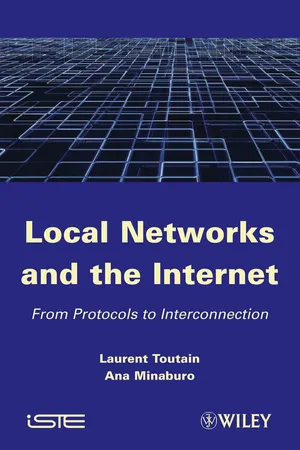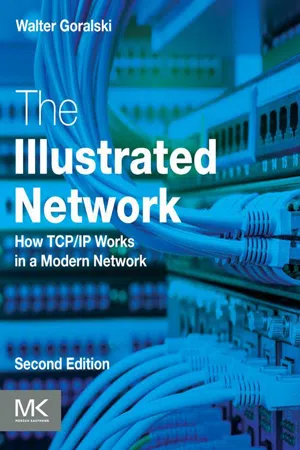Computer Science
Border Gateway Protocol
Border Gateway Protocol (BGP) is a protocol used to exchange routing information between different networks on the internet. It is responsible for directing traffic between autonomous systems (AS) and ensuring that data is routed efficiently and securely. BGP is a critical component of the internet's infrastructure.
Written by Perlego with AI-assistance
Related key terms
5 Key excerpts on "Border Gateway Protocol"
- eBook - ePub
Local Networks and the Internet
From Protocols to Interconnection
- Laurent Toutain, Ana Minaburo(Authors)
- 2013(Publication Date)
- Wiley-ISTE(Publisher)
12.4. BGP (Border Gateway Protocol)BGP is a protocol that better takes into account the complexity of routing in the Internet network. The use of BGP is not always needed. If an AS has only one attachment to a service provider, it is possible to internally announce a default route. The ISP will announce their clients’ routes. The use of BGP is justified for multi-homed sites that want to select routing and for the ISP.The version of the protocol (RFC 4271) takes into account CIDR’s hierarchical addressing. Initially BGP was defined to announce the IPv4 prefixes. The evolution of different protocols (MP-BGP: Multi Protocol BGP, RFC 4760) takes into account IPv6, multicast and MPLS.12.4.1. Message format
12.4.1.1. HeaderThe BGP protocol (RFC 4271) rests on TCP and uses port number 179. It seems strange to use a connection-oriented protocol when the internal routing protocols (IGP) directly use UDP or IP. The use of a datagram is justified in the case of the internal protocol because the use of a multicast address will allow the discovery of other routers and send the same routing table to all peers. In the case of external routing, the association is made in a point-to-point link. BGP has kept the datagram mode but the protocol is very complex.A header precedes each BGP message. As TCP is a protocol that sends a character flow, the notion of a message disappears after transmission. The receiver must cut the flow of messages. This is the header’s role.Figure 12.6. BGP message headerThe BGP header starts with a marker field over 16 bytes that contains data that the receiver awaits from the transmitter. At the moment the connection opens, all bits in this field are set to 1. The marker field is used to resynchronize the receiver. It is also used to authenticate the transmitter of the message.The next field gives the length of the BGP message. Its value is between 19 bytes (BGP header size) and 4,096 bytes. - eBook - ePub
CompTIA Network+ Study Guide
Exam N10-007
- Todd Lammle(Author)
- 2018(Publication Date)
- Sybex(Publisher)
By using the feasible distance and having feasible successors in the topology table as backup links, EIGRP allows the network to converge instantly and updates to any neighbor only consist of traffic sent from EIGRP. All of these things make for a very fast, scalable, fault-tolerant routing protocol.Route redistribution is the term used for translating from one routing protocol into another. An example would be where you have an old router running RIP but you have an EIGRP network. You can run route redistribution on one router to translate the RIP routes into EIGRP.Border Gateway Protocol (BGP)
In a way, you can think of Border Gateway Protocol (BGP) as the heavyweight of routing protocols. This is an external routing protocol (used between autonomous systems, unlike RIP or OSPF, which are internal routing protocols) that uses a sophisticated algorithm to determine the best route.Even though BGP is an EGP by default, it can be used within an AS, which is one of the reasons the objectives are calling this a hybrid routing protocol. Another reason they call it a hybrid is because it’s often known as a path vector protocol instead of a distance vector like RIP.In fact, it just happens to be the core routing protocol of the Internet. And it’s not exactly breaking news that the Internet has become a vital resource in so many organizations, is it? No—but this growing dependence has resulted in redundant connections to many different ISPs.This is where BGP comes in. The sheer onslaught of multiple connections would totally overwhelm other routing protocols like OSPF, which I am going to talk about shortly. BGP is essentially an alternative to using default routes for controlling path selections. Default routes are configured on routers to control packets that have a destination IP address that is not found in the routing table. Please see CCNA Routing and Switching Complete Study Guide: Exam 100-105, Exam 200-105, Exam 200-125, 2nd Edition for more information on static and default routing.Because the Internet’s growth rate shows no signs of slowing, ISPs use BGP for its ability to make classless routing and summarization possible. These capabilities help to keep routing tables smaller and more efficient at the ISP core. - eBook - ePub
- Ben Piper(Author)
- 2020(Publication Date)
- Sybex(Publisher)
Chapter 7 The Border Gateway Protocol (BGP)THE CCNP ENCOR EXAM OBJECTIVES COVERED IN THIS CHAPTER INCLUDE THE FOLLOWING:- Domain 3 Infrastructure
- ✓ 3.2 Layer 3
In this chapter you'll learn about Border Gateway Protocol (BGP), defined in RFC 4271. BGP was designed as the successor to the Internet's early distance-vector routing protocols, the Exterior Gateway Protocol (EGP). BGP has held the Internet together for over 30 years, a testament to its scalability and flexibility. In addition to its ubiquity on the Internet, many organizations use BGP internally. BGP is a huge topic, so we're going to focus on the aspects of it that you're most likely to encounter on the job and those most relevant to the ENCOR exam, including the following:- Differences between BGP and IGPs
- BGP AS numbers
- BGP session establishment
- Prefix advertisement
- Path selection algorithm
- Route redistribution between BGP and IGPs
- Route summarization and filtering
BGP Fundamentals
You're familiar with how IGPs make routing decisions. The limitation of IGPs is that they don't scale in very large networks, such as the Internet. Recall from Chapter 5, Open Shortest Path First (OSPF), and Chapter 6, Enhanced Interior Gateway Routing Protocol (EIGRP), that both of these protocols require propagating updates throughout the network, one hop at a time. And if a link goes down, the routers may have to perform new route computations, potentially causing packet loss. Another potential problem with trying to use an IGP in a large network is that if you ever need to merge two networks running different IGPs—such as in the case of an acquisition—you'll have the additional administrative burden of configuring mutual route redistribution, not to mention the potential for redistribution loops and routing loops.BGP was designed to allow different ASs to connect to one another over the Internet or through private networks without the risk and hassle inherent in using IGPs. According to RFC 1930, a BGP autonomous system is “a connected group of one or more IP prefixes run by one or more network operators which has a single and clearly defined routing policy.” In contrast to IGPs, BGP errs on the side of route stability and scalability, with the tradeoff being that new routes and routing updates take longer to propagate. BGP doesn't periodically send route updates at least every 30 minutes the way OSPF does. - eBook - ePub
CompTIA Network+ Review Guide
Exam N10-007
- Jon Buhagiar(Author)
- 2018(Publication Date)
- Sybex(Publisher)
BGP is often used by enterprises to either load-balance connections over two Internet providers or provide failover between two Internet service providers (ISPs). When it is used with a single connection to each ISP, it is considered a single multihomed connection. When an enterprise needs to populate the Internet with routes and a single ISP, it is considered a single-homed connection. There are other variations of the connection, but these two are the most common.BGP is resource intensive on a router when used in a multihomed connection, because your router is processing the routes learned from the ISPs. Currently there are over 600,000 IPv4 routes for the Internet that your router must learn and process. The BGP routing tables are almost one gigabyte in size, and routers often need double that in RAM to process and function; this is just for IPv4.The BGP routing protocols uses an autonomous system number (ASN) to allow routers inside an ASN to share internal routes. When the BGP peer (neighbor) routers are inside an ASN, the BGP process is considered Internal Border Gateway Protocol (iBGP). When the BGP peers are between two different ASNs, the BGP process is considered External Border Gateway Protocol (eBGP). Before you can use BGP to populate routes on the Internet, you must register for an ASN number from the regional Internet registry (RIR)—such as ARIN, RIPE, AFRINIC, LACNIC, and APNIC.When BGP routers create a peering with another router, they transmit Network Layer Reachability Information (NLRI) between each other. This NLRI is composed of length and prefix. The length is the classless interdomain routing (CIDR) notation of the network mask, and the prefix is the network address. BGP peers send a keepalive every 60 seconds via a unicast message on TCP/179. BGP is a unique routing protocol because it uses a transport layer to communicate network layer information.IPv6 Concepts
IPv6 was developed by the IETF and was published in 1998. It is now 20 years later and it is still slowly being adopted! The motivation for IPv6 was the exhaustion of the IPv4 address space; in the year 2000, half of the IPv4 addresses were allocated. Through the years since the IPv4 exhaustion was first forecasted, many technologies were developed to lessen the impact. One such technology was network address translation (NAT), covered later in this section. IPv6 has many unique features that you will learn. - eBook - ePub
The Illustrated Network
How TCP/IP Works in a Modern Network
- Walter Goralski(Author)
- 2017(Publication Date)
- Morgan Kaufmann(Publisher)
Also, we have no way to get the routing information known about LAN2 and router CE6 to LAN1 and router CE0 (and about LAN1 to LAN2). That’s the job of the Interior Gateway Protocols (IGPs), the types of routing protocols that run between ISP’s routers. Why do we need them? Let’s look at the Internet first, and then we’ll use an IPG in the next chapter so that the IPv6 ping works. The Internet and the Autonomous System Before taking a more detailed look at the routing protocols that TCP/IP uses to ensure that every router knows how to forward packets closer to their ultimate destination, it’s a good idea to have a firm grasp of just what routing protocols are trying to accomplish on the modern Internet. The Internet today is composed of interlocking network pieces, much like a jigsaw puzzle of global proportions. Each piece is called an autonomous system (AS), and it’s convenient to think of each ISP as an AS, although this is not strictly true. The idea of a routing domain —a collection of routers under the control of a single administration which determines overall routing policy—is related to the AS, but again these are not identical. Routing Protocols and Routing Policies A routing protocol is run on a router (and can be run on a host) to allow the router to dynamically learn about its network neighborhood and pass this knowledge on until every router has built a consistent view of the network “map” and the least cost (“best”) place to forward traffic toward any reachable destination. Until the protocol converges there is always the possibility that some routers do not have the latest view of the network and might forward packets incorrectly. Actually, it’s possible that some of the “maps” never converge and that some less-than-optimal path might be taken
Learn about this page
Index pages curate the most relevant extracts from our library of academic textbooks. They’ve been created using an in-house natural language model (NLM), each adding context and meaning to key research topics.




